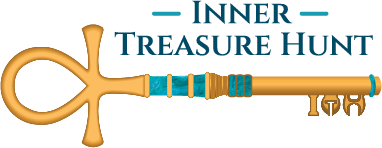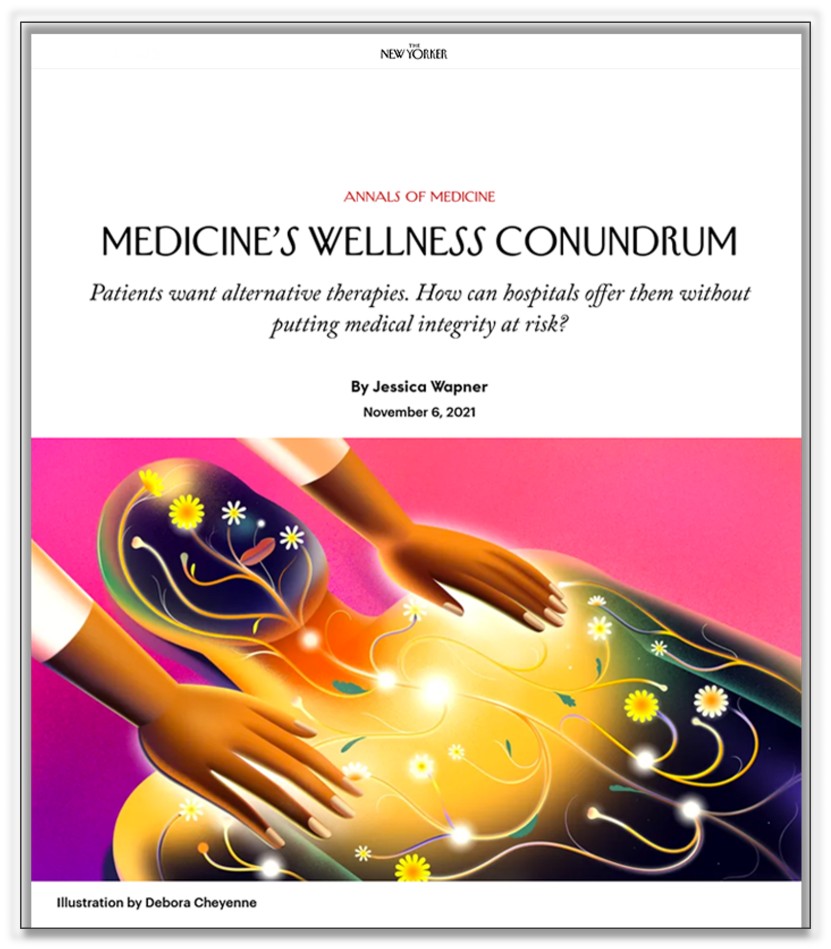Doctors and HMO’s are facing a growing number of patients suffering chronic pain or discomfort who want to include in their treatment plans alternative methods not found in the Modern Medical System such as Ayurveda, acupuncture, massage, and homeopathy, among others. How is the medical community reacting to these requests? What if anything is being done to integrate alternative approaches into healthcare? What does this mean for your health and wellbeing? Read Suteja’s answers to the questions raised in the article in her Letter to the Editor and let us know what you think.
“Medicine’s Wellness Conundrum,” The New Yorker, Nov. 6, 2021
According to author Jessica Wapner’s excellent article in The New Yorker magazine, “Medicine’s Wellness Conundrum: Patients want alternative therapies. How can hospitals offer them without putting medical integrity at risk?”, alternative treatment methods are now being requested by many more patients than in the past.
Alternative treatments, which were once viewed as kooky and fringe, are now being regularly requested by patients, and have even been incorporated by a few small healthcare providers who are on the bleeding edge of integrated healing. But the vast majority of physicians in modern medicine continue to deride alternative/integrative healing, dissuading patients who request it and refusing to refer patients to alternative practitioners. The consequences of their decisions have grave ramifications for our health and wellbeing.
Wapner’s research is thorough and eye-opening, from the birth of modern medicine’s disdain for traditional healing methods in the early twentieth century, to contemporary doctors who are alarmed at the rise of wellness and accuse providers of “snookering” patients. Even if you don’t read the article, Suteja’s Letter to the Editor speaks of her experience as an alternative healthcare practitioner, what it takes for someone to truly heal themself, and the power of patients participating in their own recovery.
Suteja’s Letter to the Editor
I read Jessica Wapner’s article about the intersection of the modern medical system and wellness with interest and hope (“Medicine’s Wellness Conundrum,” November 6th).
For many years I provided the kind of complementary care described in the article to clients who found relief from cancer pain, migraines, and fatigue among other issues. I based my care on natural and ancient healing modalities that had the most practical application, scientific research, and the results of self-experimentation. Some clients were also receiving traditional medical treatment while seeing me, and I always positioned the care they received from me as an adjunct to, not replacement for, their medical treatment. Most of my clients did not tell their doctors that they were seeing me, and the few that did reported being ridiculed or warned against charlatans, despite how good our sessions made them feel.
For millennia, humankind approached healing from a holistic point of view in which the entire person – their body, mind, emotions and spirit – was taken into consideration. Traditional techniques were administered by knowledgeable professionals thereby keeping entire civilizations alive and thriving. Everyone’s heard of yoga and acupuncture these days, but the Toltec of Mesoamerica taught citizens how to heal both their bodies and their minds on conscious and subconscious levels, transferable techniques we can use today. You would think that the healing lessons from thousands of generations might have some merit, but when the “hyper-rational world of German medicine” took over, ancient knowledge was not only thrown over but derided.
The mistake of modern medicine is to consider millennia of ancient and natural healing techniques to be of no use or out-of-date because science has made significant medical advancements in the last century. Unfortunately for patients who want to participate in their own recovery, there’s no place for them in the modern medical system because it is dehumanizing by definition. Patients are identified by their body parts (foot, arteries, head) or their symptoms (fractured, clogged, throbbing) and assigned to specialists whose job it is to fix the part or remove the symptom. Within this system, a patient is not seen as multi-dimensional being who has agency to guide their own healing, but instead as “an icon for the ‘real’ patient who’s in the computer” as Abraham Verghese is quoted as saying. Because modern medicine is doctor-centered, not patient-centered, the many layers and facets that comprise a human being and contribute to healing are ignored as if they don’t exist.
Lila Margulies’ oncologist referred to her alternative regimen, which she considered beneficial, as “witchy stuff.” But from the perspective of ancients and natural healers, it is members of the modern medical establishment that do “witchy stuff” since they behave as if people are nothing more than the sum of their (interchangeable) parts, and only believe what measurements tell them, not what patients self-report. I respect science and include recent discoveries in my educational work, but there’s more going on in healing than can be measured using twenty-first century technology.
Steven Novella says that “hospitals commit an ethical error in offering services in wellness centers…” but I would suggest that Dr. Novella is the one committing an ethical error in closing his mind to the wide array of healing modalities throughout the world that have efficacy and have been shown to work for generations. It’s unethical to deprive people of resources that have helped others, regardless of whether or not scientists can measure the effects.
So where is the hope? Dr. Elizabeth Kvale’s recognition that patients should be able to “bring their whole selves to an appointment” and her work to help move healthcare in that direction. When doctors open their minds to allow for the reality that healing comes in many forms, not just the form taught in medical school, they can present alternatives to their patients that are outside of the traditional hospital model yet beneficial. Doctors can add a proviso that their recommendations are based on what other patients have reported, not factual research results, thereby letting patients make up their own minds about what courses of action to take. And when alternative approaches provide patients with relief from suffering, doctors can listen to their self-reports with respect and encouragement rather than denigration and mockery.
The “full cycle of care” that Dr. Elizabeth Teisberg talks about will be possible when the modern medical system broadens its perspective to include other, less rational and more sympathetic, healing processes that people find beneficial. As long as healing continues to be “organized around how physicians specialize, rather than around the needs of the individual and family,” wellness interventions that encompass the whole person will be more necessary than ever.
Suteja
Co-founder, Inner Treasure Hunt
Empower yourself
Knowing that the ‘wellness’ conversation is getting bigger than ever, don’t be afraid to raise the question of alternative treatments with your medical providers and healthcare insurers. You have the right to speak up for what you want to include in your healing. It’s your body, mind and spirit, and you have the power to tap into all the layers of who you are to help yourself heal.
When the community of people requesting alternative resources gets big enough, doctors will have no choice but to change. It’s starting to happen already, and you’ll be joining the growing number of people who respect natural healing, have experienced how well it can work, and want it included in their medical treatment. Together, we can make this happen.
Resources
Read the New Yorker magazine article Medicine’s Wellness Conundrum by Jessica Wapner, co-host of the podcast “One Click” and the author, most recently, of “Wall Disease.”
Learn more about natural healing techniques and inner consciousness at Healing With the Moon, Meditation Script for Sound Healing With Your Voice, Myfascial Release Pioneer John F. Barnes, Five Ways You Can Build Resilience According to the Ancients, What Are Mandalas and How Can They Benefit You?, The Science Behind Sound Healing-Pioneer John Stuart Reid, Awakening Your Chakras, DAYS OF THE DEAD: Ancestral Healing & Conscious Dying, Meditation Script for Chakras Journey – Part 1 – Your Foundation, and Health and Wellness Pioneers Suteja and Paula Grace.
Learn more about how to take charge of your own healing in the course Self-Healing in Times of Change.
Learn more about healing and consciousness at Inner Treasure Hunt. If you liked this post, you can subscribe to the Inner Treasure Hunt newsletter to stay informed about new posts, programs, and events.
Please share this post with your friends! Just click below.

